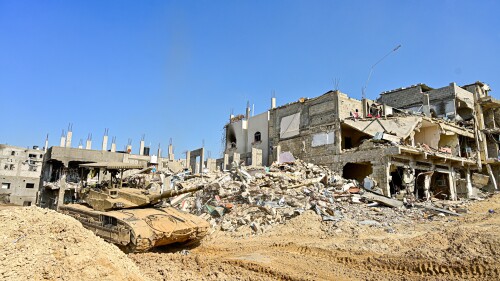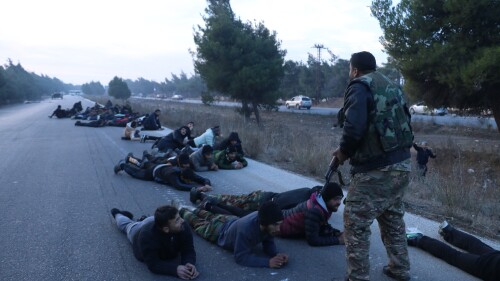Turkish President Recep Tayyip Erdoğan has threatened to invade northern Syria since May 23. |
Turkish President Recep Tayyip Erdoğan, in a speech given at a Turkish military exercise on June 9, gave the latest of a series of hints pointing to a possible upcoming Turkish military operation in northern Syria.
Speaking at the visitors day of the Turkish army’s EFES-2022 exercise in the Izmir province, Erdoğan said that Turkey is “gradually achieving our determined goal of taking our borders [with Syria] under protection with a 30-kilometer-deep security line. This legitimate security policy of Turkey not only keeps terrorist organizations away from our borders, but also contributes to the peace and stability of our neighbors.”
Erdoğan first announced this intention to carry out an additional operation in northern Syria on May 23. Ankara has already launched three major military operations in the country over the last half decade – Euphrates Shield, Olive Branch and Peace Spring, in 2016, 2018 and 2019, respectively.
The “terrorist organizations” to which the Turkish president is referring are the Syrian Kurdish People’s Protection Units (YPG) and the US-backed Syrian Democratic Forces. Ankara claims that these groups are franchises of the Kurdish Workers Party, which has been engaged in insurgency against Turkey since 1984. The groups deny this claim.
The previous three operations were all directed against the area of control of the SDF/YPG. They were intended first to break any possibility of an area of contiguous control stretching across the greater part of the long border between Syria and Turkey, and then to push the Kurdish-led forces back from the border in its entirety.
This project remains uncompleted. The Turkish leader appears now to be signaling its next phase. He has suggested that such an operation could include a strike at the areas of Manbij and Tal Rifaat. The former area is held by the SDF, while the latter has since 2018 contained, in addition to the SDF, a presence of Russian and Syrian regime forces.
So is a new Turkish operation really imminent? And why now?
A swiftly concluded operation in Syria could rally support for Erdoğan.
Regarding the timing, Turkey is currently beset by economic woes, and Erdoğan is facing an election next year. There are 3.6 million Syrian refugees in Turkey, whom the Turkish leader is keen to repatriate. The latest Turkish saber-rattling should be seen from this perspective. A swiftly concluded operation could serve to rally support and present an achievement to the Turkish public.
Turkey’s allies and its enemies appear to be taking the indications seriously. Turkish-associated Islamist military groups in northern Syria have already formed military councils which are intended to rule Manbij and Tal Rifaat after their conquest.
Barbara Leaf, assistant US secretary of state for Near Eastern affairs, meanwhile, told the Senate Foreign Relations Committee, “We are completely unstinting in our efforts with the Turkish government to back them off on this ill-considered venture. The Turkish government is very well aware of our views.”
The US remains in partnership with the SDF. Nominally, this partnership exists in order to prosecute the continuing campaign against the Islamic State organization. In reality, however, ISIS is a somewhat marginal consideration at this time. The US relationship with the SDF serves a series of additional purposes.
For a number of years, Syria has been host to a frozen conflict and to a de facto partition. There are three enclaves. The largest, consisting of about 60% of the country, is under the nominal rule of President Bashar Assad and the de facto domination of Iran and Russia. The second largest, consisting of Syria east of the Euphrates and around 30% of Syria’s territory, is ruled by the SDF and its political allies, in partnership with the US. The third area is ruled by Turkey in cooperation with a number of Sunni Islamist and jihadi militias.
Washington opposes any Turkish efforts to weaken the U.S.-backed Syrian Democratic Forces.
The US partnership with the SDF gives Washington at little cost a place at the table in any future diplomatic process on Syria. It also constitutes a large barrier to Iranian advancement east to west. For these reasons, Washington seeks to preserve this relationship and is opposed to any Turkish efforts, in partnership with local Islamist and jihadi allies, to further erode and weaken the SDF area.
Intriguingly, the Russian position regarding the possible Turkish incursion has been considerably more ambivalent. Russian Foreign Minister Sergei Lavrov, speaking on June 8 in Ankara at a joint press conference with his Turkish counterpart, Mevlut Cavusoglu, expressed “understanding” for Turkey’s “security concerns” in northern Syria.
Lavrov reserved his ire for the United States, and was expressly critical of what he termed the US “feeding” of “illegal forces” in Syria. This referred to the SDF/YPG. At the same time, Lavrov noted the importance of keeping alive the Astana talks, which bring Turkey and Iran together for discussions on Syria.
Iran is known to be particularly concerned about a possible incursion, because of the close proximity of two Shia villages, Nubul and Zahraa, to the area close to Tal Rifaat, the site of a likely Turkish offensive.Iranian and US opposition to a Turkish incursion are both predictable. Russia’s ambivalent position, however, is the most interesting.
Ostensibly, Turkey and Russia are on opposite sides in Syria. Ankara is the oldest and staunchest ally and guarantor of the Sunni Islamist insurgency in Syria. Moscow, meanwhile, is the main guarantor and the savior of the Assad regime.
A complex reality
The reality, however, is rather more complex than this simple binary. Russia understands that Turkey has needs and ambitions in Syria, which it can pursue only with Moscow’s acquiescence.
Moscow also knows that any Turkish operation in Syria would not come at the expense of its allies, the Assad regime and Iran, but, rather, at the expense of the SDF, which is a US ally and a rival to the regime (which seeks the reunification of Syria). Moscow’s sympathetic response to Ankara’s “security concerns” should therefore be seen in light of the long-standing Russian desire to draw Turkey away from its pro-Western orientation by offering Turkey prizes that the US cannot.
Turkey is a problematic partner for the West and a suitable instrument for Russia’s anti-Western plans.
Turkey’s opposition to Swedish and Finnish accession to NATO, and its sponsoring in Syria of an alliance of Islamists and jihadis, including supporters of al-Qaeda, Hamas and the Taliban, render it a problematic partner for the West and therefore a suitable instrument in Russian attempts to disrupt Western unity and cohesion. Could this extend to Russian acquiescence to an additional, limited Turkish operation in Syria?
It is worth remembering that the Turkish operation in Afrin in 2018 was possible only with Russian tacit permission. This operation was also directed against the YPG/SDF and was hence subject to the same logic outlined above.
Whether the Turkish incursion in the end happens or not, the diplomatic positioning around this issue is itself informative. It demonstrates Russian sophistication in understanding that any such Turkish incursion will result mainly in friction in the enemy camp, rather than in Moscow’s own – as long as it doesn’t go too far. It remains to be seen whether Ankara will be willing to defy US wishes and launch the threatened assault.
Jonathan Spyer is a Ginsburg/Milstein Writing Fellow at the Middle East Forum and director of the Middle East Center for Reporting and Analysis.








